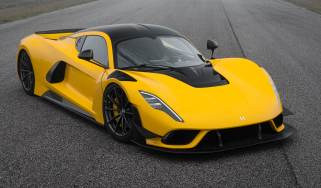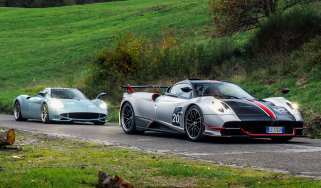Do hypercars need to get any more powerful?
The hypercar genre evolves as Ferrari F80 and McLaren W1 arrive. Dizzyingly potent but potentially less vocal and involving, the evo team wonders?

Any conversation pertaining to ‘need’ and ‘hypercars’ is almost redundant out of the gates. Of all cars, it’s hypercars that cater the least to bare motoring necessities and, indeed, to most budgets. They’re objects to experience, that exist to stoke emotions – and bank accounts too, given how the breed has become an asset class all of its own over the last few years.
With the new round of ‘Holy Trinity’ hypercars now two-thirds out in the open in the form of the newly revealed Ferrari F80 and McLaren W1, there is an interesting discussion to be had: how much power does a hypercar ‘need’? What does a hypercar actually need to do and be?
Cars such as the Gordon Murray Automotive T.50, Aston Martin Valkyrie, Lotus Evija and Pagani Utopia have recently expanded the sector in all directions. The more experiential, tactile approach of the GMA T.50 – diligently continuing the ethos that shaped the McLaren F1 – differs hugely from the uncompromising, barely road-drivable track-car approach of the ear-splitting Valkyrie, which in turn is the antithesis of the silent but violent raw power of the electric Lotus Evija and cars of its ilk. Then there’s the artisanal, sculptural artistic space that Pagani continues to occupy with the Utopia. And that’s to say nothing of Koenigsegg, Rimac, Hennessey, Mercedes-AMG, or any of the other firms that continue to sell out their seven-figure machines with each iteration.
Where do the new Ferrari F80 and the new McLaren W1 fit in, not only amongst these cars but in the context of the legendary machines they succeed, the LaFerrari and the McLaren P1?
Following the Ferrari F80’s reveal, in episode 6 of the evo Podcast, editor-in-chief Stuart Gallagher and deputy editor James Taylor joined editors-at-large Dickie Meaden and John Barker in discussing the latest and greatest from both Maranello and Woking, our expectations based on what we know so far, and whether the hypercar genre has, if anything, gone too far, in relation to the Thrill of Driving. Is 1200 brake horsepower and beyond, with a more prominent hybrid drive element, fewer cylinders and – judging by footage of the F80 so far – very little sound, where car enthusiasts want this genre to go?
You can listen to the podcast in full by searching for The evo Podcast on all established podcast platforms, and scrolling to episode 6. Here are some highlights from the conversation:

Stuart Gallagher: Ferrari has hit back [at the McLaren W1] with its F80, which is very similar but also quite different, in that Ferrari way. It’s an interesting take but there is sort of an elephant in the room: it’s not a V12.
Dickie Meaden: No, I think I've gone from one extreme to another now. I started off thinking, ‘I’m sure it’s got enormous performance, and it’s very efficient and packageable with all the hybrid stuff they need. But is it kind of missing the point, and does anyone need to go that fast, and is anyone that interested in the technology when it gives you half the number of cylinders?’ Then I saw a picture of the car without the bodywork on it and suddenly it’s like seeing the inner workings of the back of an amazing watch or similar. It looks so intriguing, and so extreme in what they’re doing. Seeing what’s under the skin, I sort of understand the way it looks now and what they’ve done. I’m really excited about how it’s going to drive. I think it’ll be quite unlike anything that they’ve built before.
Stuart Gallagher: What does it have to do to fit into that great back catalogue of Ferrari hypercars?

Dickie Meaden: The driving experience has got to be incredible to compensate for the [lack of] sound; certainly from the outside. I’m sure they’ve piped all sorts of elements of the engine noise into the cabin. [Based on the video] it doesn’t seem a particularly exuberant character, does it? Which a hypercar needs to be, so I’m guessing it’s going to have to make up for that in just how it deploys all the technology and how it puts you in the centre of it all and the way it does what it does. If anyone can do that, Ferrari can, but whether there’s still something missing – whether it is like watching the telly with a sound off – I don’t know.
> Great Ferrari hypercars driven: 288 GTO, F40, F50 and Enzo head-to-head
Stuart Gallagher: What made the LaFerrari, the F40, the F50 so special? Because you didn’t need to be driving those at their maximum, did you? A lot of it’s going to be the engine. James, you’ve only driven an F40 once, through traffic…
James Taylor: Yes, traffic in the middle of Hemmel Hempstead, which maybe isn’t the dream scenario, is it? And yet it actually still was a dream experience, because it was so totally engaging. The gearshift, and that weirdly angled steering wheel that’s a bit like a London bus... You feel so much a part of the car. The front of the engine’s almost coming into the cabin through the firewall. It was completely unforgettable.
I think the F80 – the fact it doesn’t really even have a passenger seat, it’s kind of a set of harnesses and some padding against the firewall – it could have some of that feeling of total engagement. But a lot of the F40’s sense immersion was bound up in feeling the gearshift, feeling the steering, feeling the vibrations and hearing the squeaks and rattles, because it’s raw, so it’s quite a different thing.
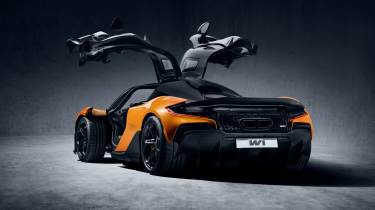
Dickie Meaden: I think it is a shame that, from what we’ve seen in the infamous Instagram videos, it seems to have so little emotion about it. You buy these things for pleasure, don’t you, and for the emotion they bring?
McLaren were very clear that they wanted this out-and-out performance, and the all-new engine is still a V8 and the electric element is all torque-fill and all performance-based. You do wonder how they’re going to drive comparatively.
Stuart Gallagher: It’ll be interesting because the ‘Holy Trinity’ were three completely different cars all aiming at the same thing, and it seems like certainly Ferrari have taken one route and McLaren have taken a completely opposite route this time. Porsche might have done a quick U-turn and be heading off in a different direction with the Mission X. I know we’ve heard between us, or spoken to friends who are in the tight circle of Porsche customers, and they were all spoken to and many said they’re not interested in EVs.
Dickie Meaden: Then you’ve got Gordon Murray doing his GMA thing. It’s a totally different world, isn’t it, the simplicity and purity of that car? All the effort’s gone into taking all the weight out of it, not adding all the technology, and hand on heart I don’t know which, if you had a GMA T.50 there and an F80 Ferrari there, where my heart be.
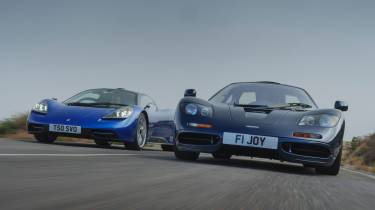
John Barker: A V12 starts off at such a higher level than something like a quiet V6 in the back of the Ferrari. Talking about the horsepower in the W1 and the Ferrari, how many people are actually going to get their toe down? Whereas you can probably still enjoy Gordon Murray’s car at any speed.
Stuart Gallagher: It’s an occasion from looking at it to getting in it to starting it up. The noises and the sensations – you don’t have to be going quickly, but that’s the same to your Ferrari F40 experience, James: it’s just the sensations around you, from gearshifts to noise.
Dickie Meaden: ‘We’ve complained about it for years, this sort of merry-go-round where big brands can only replace a car with something that’s faster, more powerful. None of them have been prepared to step off. GMA weren’t on it in the first place, were they? They could just make a statement and do their own thing, and that has its own appeal. The main manufacturers have got themselves in a position where it’s absurd – a 296 has 800 horsepower, twice what an F40 was.
Stuart Gallagher: I’ve had that very conversation with the CEO of a supercar company: ‘Why does your next car have to be more powerful, faster than the existing one which no one’s ever stepped out of and said, ‘That needs more power, needs to be faster’? He was very honest: ‘If I presented to the marketing team that our next halo car is going to have less power and less performance, but it’s going to be lighter, better to drive, more efficient, and from a business point of view more profitable because we’re not going to have to throw all this stuff at it, they would just laugh me out the room.’ Because it’s much easier to sell ‘bigger is better’.

Dickie Meaden: Everyone’s programmed to think that, aren’t they? But if you looked at the people who are buying them because it’s a car they want to drive, I wonder how many of them would actually hand-on-heart say, ‘I prefer driving this to my F50’.
It's like everything’s been shaken up and it’s just where it’s all going to settle now; whether people end up preferring the ultra-powerful, ultra-high-performance things that you can only really drive on track.
John Barker: We’ve been on group tests where I can remember chasing somebody, me in a 911, which had 500 horsepower, and he was in the 700-horsepower Ferrari Pista, and he couldn’t get away. There’s only so much you can use. You know it’s a finite amount that you can deploy on a decent road where you want to drive.
Dickie Meaden: I drove a Chiron on the launch – I’m just having flashbacks to deploying the performance. The speed you go on a normal road… It’s a ‘lock you up and throw away the key’ job. It’s ridiculous and yet they do it. I think what people don’t appreciate about the really, really fast cars is that, when you drive a normal car, it takes about half an hour to row it up to 100mph; in a super-quick car you’re there and back before a normal car would have got to 60, so you can theoretically use lots of performance in these cars, but still there’s still so much that you’re not even tapping into. I think this is what we’ve struggled with for a long time. All you’re getting with the next-generation car is even more of that frustration – the performance reserve which you’ll never exploit. And all of that comes with more weight and bigger tyres.
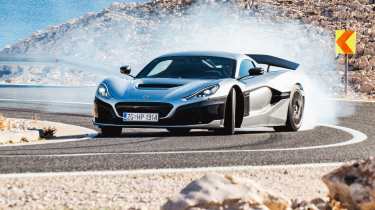
Stuart Gallagher: I think that’s where the electric hypercars have fallen flat completely, isn’t it? Because it’s their USP, their sales pitch: 2000 horsepower but no one can comprehend where you’re going to use it.
James Taylor: I drove the Rimac Nevera quite briefly, but enough to know it’s dizzyingly fast and, with the lack of sound, you feel a bit disorientated by it as well. I mean, I came away thoroughly impressed by it, but I think I felt like there was so much more performance I hadn’t used. I almost felt… ‘frustrated’ is the wrong word, but I think I had more satisfaction from wringing out a slower car and feeling like I was using all the performance, but even so, it was fast enough for me. The Lotus Evija prototype I drove in 2022 was running 1600 horsepower and you'd be spinning a wheel without realising you were spinning it down the straight.
Stuart Gallagher: It’s that desire thing, isn’t it? If you had a GMA or an F80 or an Evija parked outside, there's two cars that would be tugging at your heartstrings – which one do I drive? I can only drive one of them and I think there might be an intrigue level in the Evija, but not at the expense of not driving the others. It’s the sort of thing you want to drive once and then maybe once you’ve driven it, you don’t really need to drive it again, but that’s not a great ownership proposition is it?

